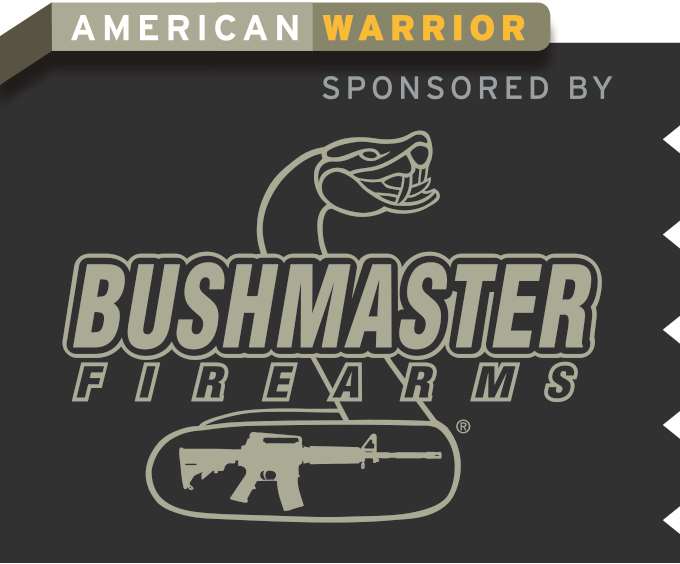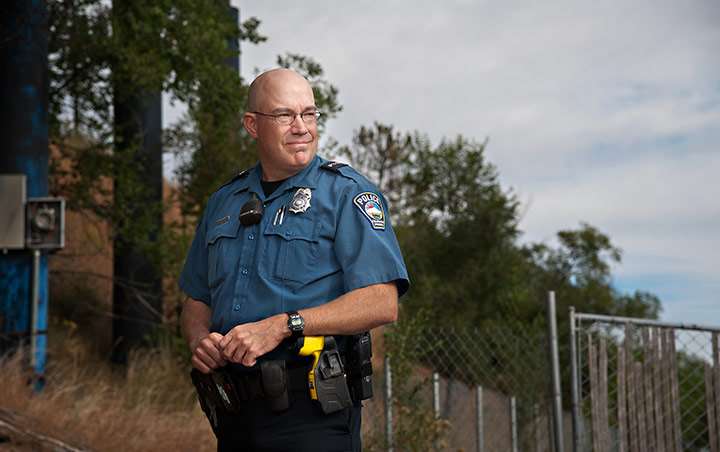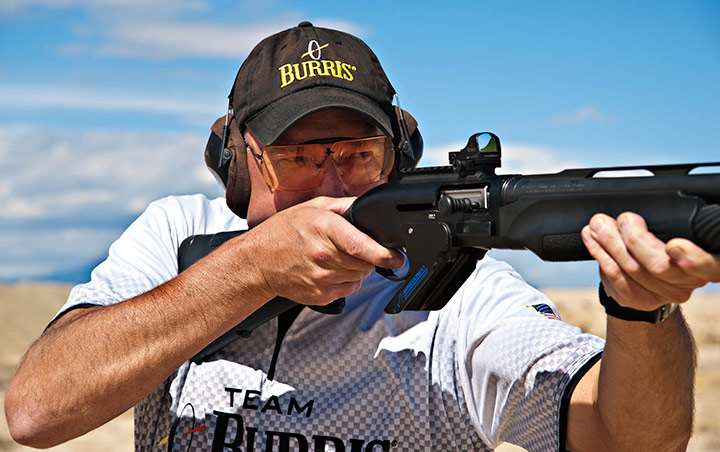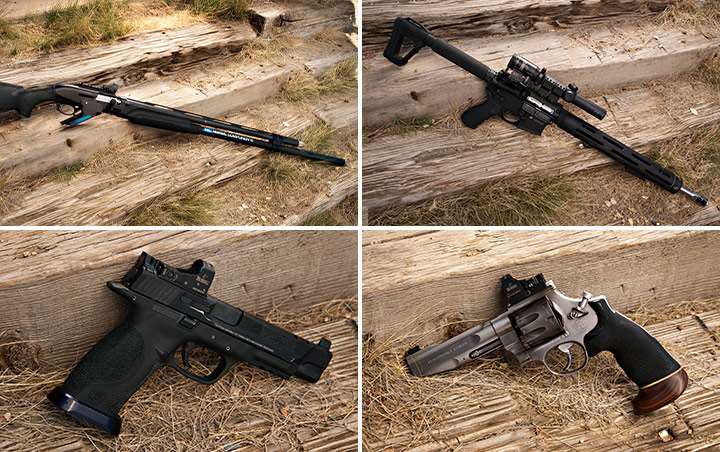
The 2014 shooting season started on a down note for World Champion Law Enforcement 3-gun shooter Craig Calkins. On day two of the Superstition Mystery Mountain 3-Gun Match in Mesa, Ariz., Calkins' AR-15 suffered a huge trigger problem.
The trigger pin had snapped in two, and one side had worked itself out. He was able to get a few shots out of the gun before abandoning it and transitioning to his shotgun to complete the stage. The result was numerous un-hit targets, a boatload of penalty time added to his raw stage time and a finish out of the top 10.
That was a rough way to start the 2014 season, but a rare—indeed mighty rare—one for Craig Calkins, who is accustomed to being at the top of the leaderboard at most matches.
A Colorado Springs Police Department officer, Calkins has come a long way in many senses of the phrase. He started his law enforcement career in 1990, working for a small Sheriffs Department in McLean County, N.D. After a few years there he moved to the Mandan (N.D.) Police Department, then on to the Bismarck P.D.
At Bismarck, Calkins worked in Patrol and in the Traffic Unit until heading west for Colorado Springs in 2001. Calkins grew up shooting and hunting with his father, but didn’t begin competitive shooting until the mid ’90s. There was no on-duty, near-death experience that caused him to want to become more proficient with a handgun. His in-laws just happened to be avid competitive shooters, so he figured he’d give it a try. At the time, his duty sidearm was a semi-automatic pistol, but all the shooters at the local matches were using revolvers. “When in Rome,” he figured, and grabbed a revolver.
Calkins’ home range in North Dakota was set up around Bianchi Cup matches, which place an emphasis on accuracy. Back then, gunsmiths were still figuring out how to make a semi-auto like a 1911 accurate enough to compete with a tuned revolver, but this wasn’t a problem for Calkins. He excelled at Bianchi events with a six-shot wheel gun. The first big match he attended was the 1997 International Revolver Championship in Montrose, Colo. It wasn’t a Bianchi match, but Craig’s underlying skills allowed him to do well for a first-time IRC shooter.
While there, he got his first exposure to the advancing revolver technology of the time—moon clips versus speed loaders, and seven- and eight-shot revolvers. It wasn’t long before Craig had a then newly introduced 8-shot Smith & Wesson 627 chambered in .38 Special. Shortly after the 1997 IRC, his home range began to transition away from Bianchi to faster-paced Steel Challenge-type matches. The hook, shall we say, was set.
In Colorado Springs, Calkins worked Patrol until late 2002, when he moved to the Traffic Crash Unit. He served there for five years, did another short stint in Patrol and then moved on to the DUI Enforcement Unit, where he has been assigned since.
Nowadays on the competitive front Calkins focuses on 3-gun matches. Colorado has a very active 3-gun and practical shooting community, so during a typical month he might attend several local 3-gun matches, three or four weekday afternoon Steel Challenge matches and a local USPSA/IPSC match or two. In 2013, Burris Optics hired Calkins for its Pro Staff. In 2014, R&R Targets was added to his sponsor list.
This summer, the World 3-Gun Championship was held close to home for Calkins at the NRA Whittington Center in Raton, N.M. After five days of shooting on stages at over 6,000 feet elevation, he finished as the No. 1 cop in the world, and took second place in the Open Division right behind shooting legend Jerry Miculek.
For 3-gun, Calkins regularly shoots in the Open Division, pretty much a “hot rod, anything goes” game when it comes to firearm selection and modifications. As long as it is safe and meets a few guidelines (no full auto, for instance), a competitor can run the gear he or she sees fit.
Calkins’ shotgun is a Benelli M2 with an extended magazine tube that holds 15 shells. To feed his shotgun he uses homemade tube loaders that hold four to six rounds. His shotgun also fields a compact Burris Fastfire II red dot.
“He (Calkins) is the most aggressive and fastest shotgun shooter I have ever seen,” a top level 3-gunner told me at a match earlier this year. “And I have been playing the game for more than 20 years.”
Calkins enjoys 3-gun more than other competitive shooting disciplines because of the variety of challenges it presents. Competitors can find themselves shooting a rifle from 5 yards to 400 yards, or a shotgun out past 75 to 100 yards. Most pistol shots in 3-gun matches range from point blank out to 40 or 50 yards.
Just this summer, Calkins transitioned to shooting a 16-inch JP Enterprises rifle. The low-mass operating system is designed to further reduce recoil when shooting fast. For optics, he uses a Burris XTR 1-4 for distance, with a Fastfire III mounted forward and canted off to the side for close-up targets.
Calkins also changed pistols this year, moving to a Smith & Wesson M&P CORE, again with a Burris Fastfire III on top. This is a non-trivial advantage, as he carries an M&P on duty. Also, on a stage where a firearm must abandoned in a dump box, there’s no safety to apply on the striker-fired Smith—another advantage.
Of course, Calkins still shoots a revolver now and then. Most of his revolvers are set up for double action only and have Apex Tactical hammers.
Craig does the trigger work for these pistols himself. Recently he and I pulled a barrel off one of his S&W 627s. I asked him how many rounds he had through it, as the rifling had clearly seen better days. His guess was somewhere around 125,000 rounds. Knowing that he has two almost identical 627s that he uses equally, that’s a lot of shooting!
During the summer months Calkins shoots lots of Steel Challenge matches with all types of firearms. He uses everything from a Ruger 10/22 rifle, to a Ruger MK III pistol, to a Smith and Wesson M&P-15/22, to his M&P CORE. All of them have some sort of optic on them, allowing him to use these matches as cross training for his 3-gun endeavors.
Calkins said shooting lots of different competitions benefits him as a cop in many ways. One of the biggest benefits comes from being able to take a short look at a situation (match stage) and quickly come up with a plan to negotiate it.
“It’s problem solving 101,” he said. “There’s no mystery to how this helps on the job, where long looks may be a tactical impossibility. Things such as shooting off rooftops, under cars and around barricades can do nothing but help me out on the street if the need to use deadly force should arise.”
Calkins added that another benefit of competitive shooting is the ability to deal with the stress of equipment malfunctions.
“In the line of duty, if a firearm was to go down, my familiarity allows me to clear it or decisively transition to another,” he said.
“Sometimes while at the PD range, other officers will ask me about how to shoot faster or be more accurate,” he continued. “Oftentimes, I end up talking to them about the different matches and how they can help develop skills that normal officers are not exposed to during firearm qualification training. It’s about shooting more, but also in more varied situations. Competition provides that.”
A few weeks after Calkins’ so-so finish at the SMM3G match in March, he went to the USPSA 3-Gun National Matches and finished 11th. A couple of months later, he had a solid second-place finish at the Rocky Mountain 3-Gun World Match. Then just a few weeks later, he solidly won the Area 2 USPSA 3-Gun Championship.
Of course, all that successful competition comes at a price. In an average month, Calkins might shoot 600 rounds of shotgun, 800 rounds of rifle and more than 1,000 rounds of pistol ammo. Some of that is in matches but—no surprise—a lot is in practice. He spends his time off reloading ammo, cleaning guns, fixing guns or shooting. Somewhere in there he remembers to eat and sleep.
Two of his favorite matches—competitions he seldom misses—are the International Revolver Championship (IRC) and the Rocky Mountain 3-Gun (RM3G). The IRC is a very laid-back match where everyone is shooting the same gun, resulting in a true apples-to-apples test of revolver skill. The community is pretty small, so it’s a competition largely among old friends. RM3G is a more complex affair—an open terrain match held at the NRA Whittington Center. Run around those hills, shoot all three guns well and quickly. The variety of shooting challenges that can be set up there is pretty much endless.Calkins’ advice to anyone wanting to get into competitive shooting is to go to a match and check it out.
Five years from now Craig still sees himself with CSPD and working hard to dominate 3-gun competitions. I have no doubt he will always do well at both.
Calkins’ advice to anyone wanting to get into competitive shooting is to go to a match and check it out. However, he advises new competitive shooters to not spend a ton of money without talking to guys that have already been around the block. They’ll have some good advice on equipment.
And remember, everyone had a first match—complete with nerves, mistakes and all the other first-match foibles. The biggest thing is to just get out there and give it a shot.


































